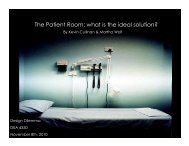The role of physical design and informal communication
The role of physical design and informal communication
The role of physical design and informal communication
You also want an ePaper? Increase the reach of your titles
YUMPU automatically turns print PDFs into web optimized ePapers that Google loves.
Table 13 Frequency <strong>of</strong> location by person<br />
Location No One Patient Visitor Nurse<br />
Person<br />
Doctor AH Orientor GN<br />
Med Room 48.2% 0.0% 0.0% 21.3% 0.0% 0.8% 23.7% 6.3%<br />
Charge Desk 11.8% 0.0% 2.9% 41.2% 20.6% 2.9% 20.6% 0.0%<br />
Corridor 37.4% 1.7% 3.9% 24.3% 2.2% 13.5% 16.1% 2.2%<br />
Nurses Station 36.4% 0.0% 1.3% 23.2% 3.3% 11.3% 25.2% 2.3%<br />
Patient Room 0.0% 100.0% 15.2% 10.1% 4.6% 14.3% 9.5% 1.8%<br />
Frequency<br />
45%<br />
40%<br />
35%<br />
30%<br />
25%<br />
20%<br />
15%<br />
10%<br />
5%<br />
0%<br />
Med Room Charge Desk Corridor Nurses<br />
Station<br />
Location<br />
Figure 32 Frequency <strong>of</strong> location by person<br />
Patient Room<br />
Nurse<br />
Doctor<br />
AH<br />
Orientor<br />
As table 14 <strong>and</strong> Figure 32 illustrates, 30.8% <strong>of</strong> all interactions with nurses<br />
occurred at the nurses station 24.7% occurred in the corridor, <strong>and</strong> 23.8% occurred in<br />
the med room. Interactions with the Orientor followed a similar pattern, with 36%<br />
occurring at the nurses station, 28.4% occurring in the med room, <strong>and</strong> 17.5%<br />
occurring in the corridor. Observation confirmed that interaction with nursing<br />
assistants (included in the allied health category) <strong>of</strong>ten occurred either in the corridor<br />
(27%) or at nurses station (29.6%).<br />
89







